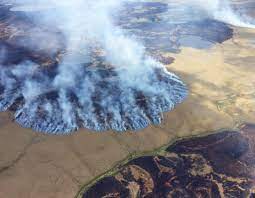Zombie Fire:

As global temperatures rise, fires are also spreading farther north and into the Arctic , which is causing an increase in “zombie fires.”
- Zombie fire is a fire from a previous growing season that can smoulder under the ground which is made up of carbon-rich peat.
- These fires also produce more smoke because of their lower temperature of combustion.
- It occurs as the organic-rich Arctic soils dry up because of changing climate conditions, they can burn slowly and release vast amounts of smoke into the atmosphere.
- One major culprit is the rising temperature: The Arctic is warming nearly four times faster than the rest of the world, a phenomenon known as Arctic amplification.
- Among the changing conditions that favour wildfires are changes in atmospheric circulation that create periods of extreme heat, dry out vegetation and reduce moisture in soils, and, importantly, lead to more frequent lightning strikes that can spark blazes.
- As the Arctic warms and fires move farther northward, peat soils rich in dead plant material burn at an accelerated rate.
- The burning peat also removes the layer insulating permafrost, the region’s frozen carbon-rich soil.




